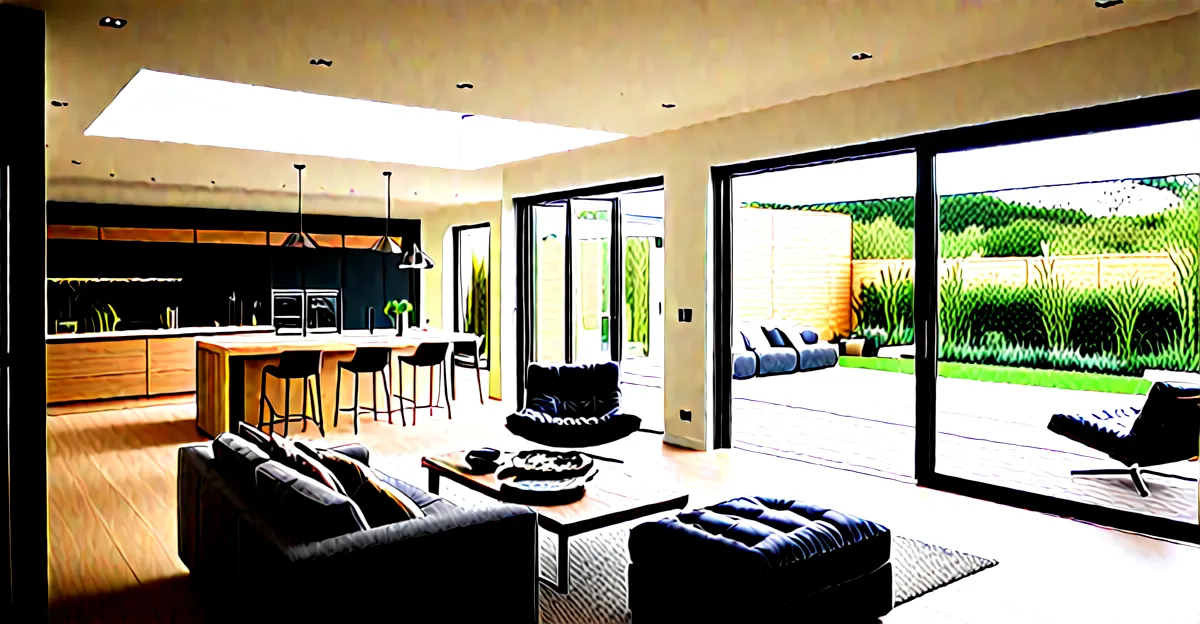Understanding Mindful Home Design
Mindful home design is a transformative approach that goes beyond aesthetics, emphasizing the connection between the home environment and mental health. At its core, mindful design concentrates on creating spaces that foster peace, clarity, and a sense of well-being. By aligning our living spaces with well-being principles, we can profoundly impact our mental and emotional states.
Definition and Principles
This might interest you : How Can You Transform Your UK Home into a Green Living Space?
Mindful design integrates thoughtful elements that prioritize comfort, functionality, and aesthetics, ensuring each space supports the inhabitants’ needs and emotional well-being. This approach involves deliberately organizing, decorating, and structuring a home to promote relaxation and positivity. Key principles include simplicity, balance, and the inclusion of natural elements.
Relationship with Mental Health
In the same genre : What Unique Challenges Come With Decorating a Living Room in the UK?
A well-structured home environment can significantly affect mental health. Clutter-free, harmonious spaces have been linked to reduced stress and anxiety levels. By incorporating mindful design principles, we can create environments that support a more profound sense of peace and mental clarity.
Enhancing Well-being Through Design
Several key concepts enhance well-being through mindful design. These include using calming colours, incorporating nature, emphasizing natural light, and ensuring layouts are open and inviting. Each of these elements plays a role in nurturing a positive, energizing atmosphere that can uplift mood and enhance overall well-being. By focusing on these aspects, individuals can design a home that not only looks good but feels good too.
Elements of Mindful Home Design
Incorporating thoughtful design elements in your home can significantly enhance your living experience and well-being. Understanding how natural light, open spaces, and the use of natural materials impact your environment is vital for creating a mindful home.
The Role of Natural Light
Natural light is a crucial factor in home design, profoundly affecting mood and energy levels. Rooms filled with daylight can uplift and energize, while dim, poorly-lit spaces may foster lethargy and sadness. As exposure to natural light regulates the body’s circadian rhythms, it’s essential for mental alertness and overall health.
Importance of Open Spaces
Open spaces in the home contribute to a sense of freedom and openness, which is vital for mental clarity. Removing excess furniture and creating spacious layouts can help reduce stress and foster a calming atmosphere. Open areas also encourage movement and ease, promoting physical well-being alongside mental benefits.
Use of Natural Materials
Choosing natural materials, such as wood or stone, in your home design can have a positive impact on your health and sustainability. These materials often contain fewer chemicals and are more environmentally friendly compared to synthetic options. Their textures and warmth can create a grounding and soothing atmosphere, further supporting a mindful home environment. By focusing on these design elements, you can cultivate spaces that nurture and align with well-being principles.
Practical Tips for Mindful Home Design
Creating a mindful home environment involves practical strategies that enhance both aesthetics and well-being. By integrating design tips that align with well-being principles, you can transform your living space into a sanctuary of relaxation and clarity.
Simple Design Strategies
Adopting simple, intentional design strategies can make a significant impact on your home environment. Start by decluttering spaces to reduce stress and create an open, peaceful atmosphere. Choose versatile fixtures and furniture that adapt to multiple functions, keeping spaces balanced and harmonious.
Choosing Colors for Calmness
Selecting the right color palette is essential in fostering a tranquil home environment. Calming colors such as soft blues, gentle greens, and neutral tones can soothe the senses and promote relaxation. These hues work best in areas meant for unwinding, like bedrooms and living rooms, where serenity is paramount.
Incorporating Nature
Bringing the outdoors in is a powerful way to enrich your living space. Incorporating nature through indoor plants and indoor gardens not only purifies the air but also elevates mood and reduces anxiety levels. Position plants in areas with ample natural light to enhance their growth and your connection with nature.
By embracing these practical tips, you can create a mindful home design that supports a positive and harmonious lifestyle.
Scientific Research on Home Design and Well-being
Scientific studies have long explored the relationship between home design and psychological health. Various researchers have demonstrated the impact of thoughtful home environment design on mental health and overall well-being. Such research highlights how mindful design principles—for instance, incorporating open spaces and natural light—foster significant health benefits.
Research indicates that spaces with abundant natural light positively affect our neurotransmitters, enhancing mood and promoting cognitive function. A well-lit home environment reduces symptoms of depression and improves productivity. In contrast, cluttered, dimly lit spaces have been correlated with increased stress and anxiety, underscoring the crucial role lighting plays.
Further evidence supports the notion that open spaces within a home contribute not only to physical health but also to psychological clarity. Studies reveal that environments allowing free movement and minimal clutter elevate mood and even enhance creativity. The absence of visual and physical congestion in open spaces aids in fostering mental relaxation, illustrating the importance of spacious layouts in mindful home design.
Natural materials and their textures have also been linked to a sense of calm and grounding. Scientific findings show that these materials, like wood and stone, can foster an atmosphere of serenity and environmental consciousness, significantly impacting our well-being. Their sustainable nature often aligns with health-conscious living, reducing exposure to harmful substances present in synthetic materials.
In summary, scientific research compellingly supports the integration of mindful design elements within our living spaces. These studies underscore the tangible health benefits of intentionally designed home environments, illustrating the profound connection between our surroundings and our psychological health. Embracing these insights can lead to a more holistic approach to home design, yielding long-term enhancements in well-being.
Case Studies in Mindful Home Design
Exploring real-world applications of mindful design reveals its transformative power in enhancing well-being. Case studies provide valuable insights into the practical benefits and impact of such design principles.
Transforming Spaces for Better Well-being
Numerous projects have effectively utilized mindful design to revamp spaces, demonstrating improved well-being for occupants. A notable example includes the redesign of a residential complex, where the integration of natural light and open layouts resulted in a noticeable uplift in residents’ moods and productivity. Emphasizing wellness through design, these spaces featured green elements and calming color palettes, aligning with well-being principles.
Community Projects Using Mindful Design
Community initiatives have harnessed mindful design to create environments promoting collective wellness. Some neighborhoods transformed unused plots into gardens and green spaces, encouraging outdoor activities and fostering social interaction. By prioritizing these design elements, communities reported enhanced connectivity, increased physical activity, and reduced stress levels among residents.
Feedback from Residents on Design Impact
Residents often express profound positive shifts after their surroundings incorporate mindful design. Testimonials highlight improvements in mental health, with individuals noting reduced anxiety levels and greater daily satisfaction. For instance, a couple in a renovated mindful home praised the inclusion of natural materials and light, attributing these features to an enhanced sense of peace and contentment. Real-life feedback underscores the tangible benefits of adopting mindful design practices within living environments.
Conclusion: Embracing Mindful Home Design for Better Living
Mindful home design is more than just a trend—it’s a transformative approach that integrates well-being benefits directly into your lifestyle. By focusing on creating spaces that are not only beautiful but also aligned with well-being principles, mindful design encourages a harmonious living environment that nurtures both body and mind.
To truly embrace mindful living, it’s essential to integrate small yet impactful lifestyle changes into your home decor. Consider the inclusion of calming colors, natural light, and open spaces to foster a serene atmosphere. These simple adjustments don’t just elevate the aesthetic of your home; they serve as foundational elements in building a mindful living environment.
Adopting these practices in your home design can lead to profound enhancements in your daily life. As testimonies and case studies in mindful design reveal, even minor tweaks can yield significant psychological benefits, contributing to reduced stress, heightened mood, and an overall sense of peace. Taking the leap to transform your home into a sanctuary begins with understanding the critical role your surroundings play in shaping emotional well-being and committing to integrating these principles into your every day.
By embracing mindful home design, you’re making a conscious choice to prioritize mental health and quality of life. This holistic approach not only enhances the physical aesthetics of your space but also fosters a nurturing environment where you and your loved ones can thrive. Whether through simple design tips or comprehensive renovations, remember that every step towards mindful living is a step towards a more fulfilling and balanced life.






